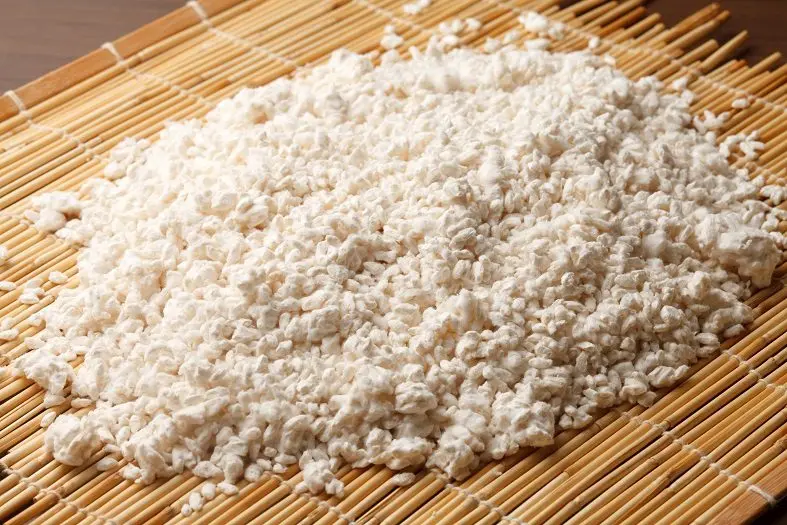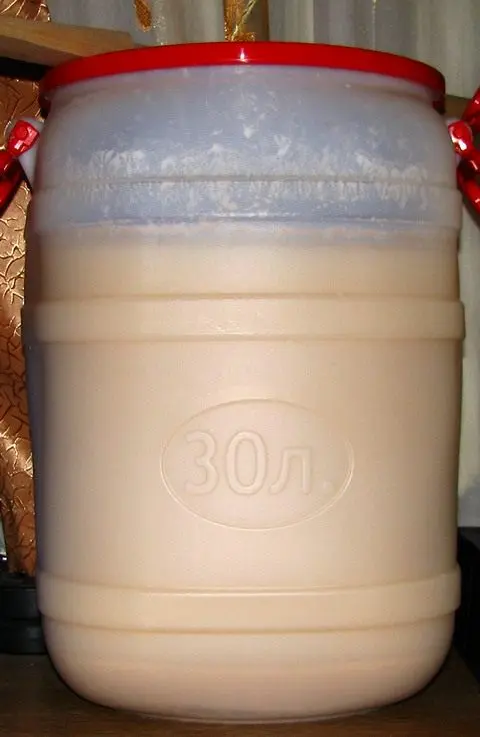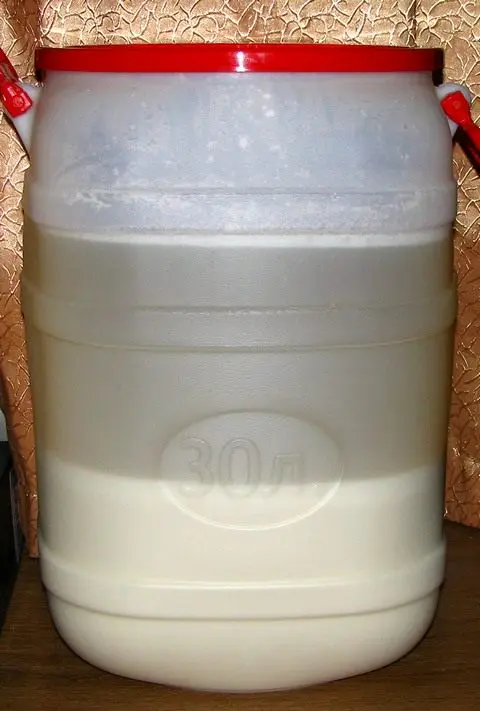Experienced distillers know that in Asian countries, for the preparation of alcoholic beverages from starch-containing raw materials (rice, barley, corn, wheat), special mold-based yeasts are used – Koji, which saccharify starch (processed into sugar) without malt and enzymes. Recently, Chinese-made Koji yeast appeared in Russia, which caused considerable excitement among moonshiners. It’s time to understand the advantages and disadvantages of this product, which is positioned as an easier alternative to traditional methods of making mash.
Theory
Real Japanese koji (糀) are rice or soybeans that have been steamed and fermented with the fungus Aspergillus oryzae. For successful reproduction and processing of raw materials, fungal spores create special conditions:
- The rice is washed and soaked.
- The grains are steamed, cooled and spores purchased from certified suppliers are introduced. In Japan, only 10 companies are authorized to trade Aspergillus oryzae.
- Rice “infected” with the fungus is poured into a wooden container and transferred to a temperature-controlled room.
- During the saccharification process, rice is periodically stirred, the temperature is controlled, cooling and heating the grains as needed.
- The cooked rice is covered in white flakes and has a sweet taste. Raw materials are immediately sent for processing (fermentation, preparation of soy sauce, marinade for fish or other dishes), because they have a short shelf life.

It follows that, at best, only Koji spores (Aspergillus oryzae), called “starter”, can be purchased. First, the fungus will need to be activated, and then grown and propagated on steamed rice using a certain technology, observing the temperature regime. To move mold spores across the border, a special permit from the phytosanitary services is required, so it will not be possible to legally buy Koji.
Now let’s figure out what is actually sold via the Internet under the guise of a mold fungus, for example, the Angel company, well-known in Russia. At the heart of Chinese Koji is a concentrated substrate processed by mold bacteria and containing a complex of amylolytic enzymes that break down starch into simple sugars. By the way, amylase is part of the yeast of all more or less well-known manufacturers, even Belarusian ones.
Simply put, Chinese koji is a mixture of dried vinasse of rice mash, artificial enzymes for cold saccharification of starchy raw materials, conventional yeast and nutritional supplements that promote fermentation. The mold fungus itself is dangerous to health, so active spores are killed long before packaging; it will not work to grow real Koji from such a composition.

Despite the obvious substitution of concepts, in some cases the use of Chinese yeast is justified. Further in the course of the article, by the word “Koji” we will understand exactly the substitute with enzymes, and not the real fungus Aspergillus oryzae.
Benefits of Koji Yeast:
- ease of working with starch-containing raw materials – no need to boil flour, and then saccharify the mash with malt or enzymes, everything you need is already in the bag with yeast, just add water;
- with the right technology, the distillate retains the organoleptic properties of the feedstock, as in the case of the use of malt;
- ready-made mash does not burn when the distillation cube is directly heated (without a steam generator);
- almost all starch is processed into sugar, which allows you to get the maximum moonshine.
Disadvantages of “Koji”:
- the average fermentation time is 25 days, which is several times longer than with traditional malt saccharification;
- during fermentation, a very unpleasant, rotten smell appears;
- price – the cost (including delivery) of Chinese yeast with enzymes is higher than that of ordinary bakery and even spirit yeast.
Attention! Although active spores of the fungus must be destroyed at the factory before packaging, but for reinsurance against allergies, candidiasis and bronchial asthma, I advise you to adhere to safety precautions: work with yeast only with gloves and prevent the powdery composition from entering the lungs, protecting the respiratory organs with a mask or respirator. Braga cannot be tasted.
Universal Koji Braga Recipe
Ingredients:
- starch-containing raw materials (any flour or finely ground cereals) – 5 kg;
- water – 20 liters;
- koji – 45 grams.
Features. Instead of cereals or flour, pure starch can be used. The instructions for yeast indicate that the ratio of water to raw materials should be 3 to 1, but to reduce the duration of fermentation, it is better to make the hydromodule larger – 4: 1, excess water will definitely not worsen the mash. It has been experimentally established that 1 grams of “Koji” (the optimal amount) is required per 9 kg of cereals or flour. The maximum possible strength of the mash is 15% (indicated by the yeast manufacturer).
The yield depends on the starch content of the grain. Theoretically possible values are given in the table, in practice the yield is usually lower by 10-15%.
| Raw materials | Alcohol, ml/kg |
|---|---|
| Wheat | 430 |
| Barley | 350 |
| Rye | 360 |
| Corn | 450 |
| Oat | 280 |
| Peas | 240 |
| Millet | 380 |
| rice | 530 |
| beans | 390 |
| Potatoes | 140 |
| Starch | 710 |
| Sugar | 640 |
Braga preparation technology
1. Disinfect the fermentation container: dilute pharmaceutical iodine in cold water (10 ml per 25 liters), pour the solution into the container along the edge, leave for 60 minutes, then drain the product. If the material permits, steam sterilization or any other method can be used instead of iodine.
Due to the slow fermentation, there is a risk of contamination of the wort with pathogenic microorganisms, so the disinfection of containers and raw materials is a mandatory procedure and is provided for in the yeast instructions.
2. Pour boiling water over the cereal (flour) and mix (also for disinfection purposes). Wait until the wort has cooled down to 30-32°C.
3. Add Koji yeast. Stir, install a water seal (you can use a glove with a hole in your finger).
Attention! Due to the low intensity and protracted fermentation over time, the use of a water seal is mandatory, otherwise the mash will turn sour!
4. Move the mash to a dark place with a stable temperature of 20-28°C (recommended – 25-26°C). Stir once every 5 days so that the enzymes break down the starch at the bottom. The first signs of fermentation appear after 6-20 hours.

Ready for distillation mash on Koji becomes lighter, a layer of sediment appears at the bottom, and the intensity of gas release from the water seal noticeably decreases (the glove deflates). You can’t taste it! Usually, at the recommended temperature, fermentation lasts 20-28 days.

Obtaining moonshine from koji
5. Although the wort is not afraid of direct heating, for reinsurance before distillation, it is better to filter the mash through gauze and squeeze the cake well.
6. Make the first distillation at maximum speed. Select moonshine before the drop of the fortress in the jet below 35%. Depending on the raw material, a specific odor may occur.
7. Determine the amount of pure alcohol in the resulting distillate (volume in liters multiplied by the percentage of strength and divided by 100).
8. Dilute moonshine with water to a strength of 18-20 degrees and overtake again with separation into fractions. Collect the first 15-18% of pure alcohol separately. This harmful fraction with an unpleasant odor is called “head” and is suitable only for technical needs.
Usually the “heads” account for 8-12% of the “pervacha” of pure alcohol, but in the case of Koji, it is better to remove more distillate to improve the quality.
9. Collect the main product (“body”) until the strength in the jet falls below 50%, then finish the distillation or select the “tails” separately.
10. Dilute the “body” with water to the desired strength (usually 40-45%), pour into glass containers and seal tightly. Leave for 2-3 days in a dark place to stabilize the taste.











Pilnīgs sūds, tā ir krāpšana, darīju visu pēc receptes, 12kg kviešu 2 pac kodzi un 3 l 30 gadīgs, suds